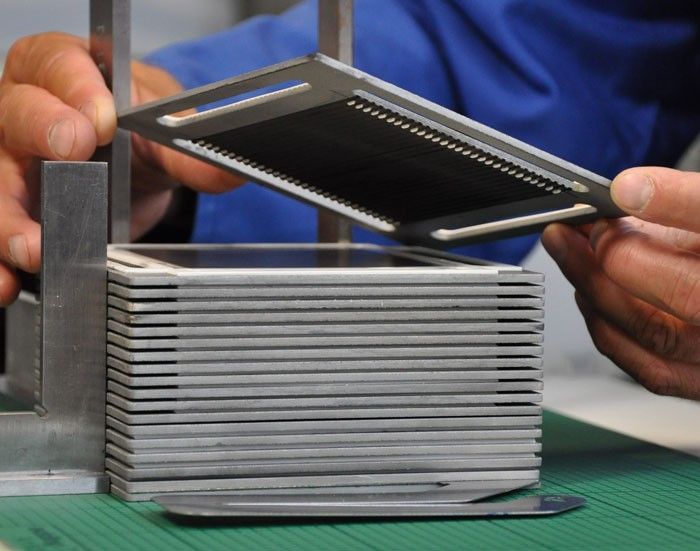thyssenkrupp nucera, Fraunhofer IKTS Partner for High-Temp Electrolysis Technology
The institute has been researching solid oxide electrolyzer cell technology for 20 years, and the partnership with thyssenkrupp nucera is the next step toward industrial manufacturing applications for hydrogen production.
thyssenkrupp nucera and the Fraunhofer Institute for Ceramic Technologies and Systems (IKTS) entered a partnership to strengthen their technology portfolios with high-temperature electrolysis technology, which will be applied toward industrial manufacturing applications.
A pilot plant planned and built by Fraunhofer IKTS is slated to begin operation at the beginning of 2025 to produce high-temperature electrolysis stacks with solid oxide electrolyzer cells (SOEC). These cells are the primary elements of SOEC stacks and will be produced in small quantities upon plant start-up. The partnership also includes a license for thyssenkrupp nucera’s production and use of chromium-based alloy (CFY) stacks based on the SOEC technology of Fraunhofer IKTS.
“With SOEC system solutions, we are consistently implementing our company’s growth strategy. With high-temperature electrolysis, we will offer our customers a powerful technology that will be another pillar of the new, CO2-free and therefore climate-friendly energy mix of the future without fossil fuels,” says Dr. Werner Ponikwar, CEO of thyssenkrupp nucera. “Through the strategic partnership with Fraunhofer IKTS, we are strengthening our hydrogen product portfolio with a second high-performance technology for industrial scale in addition to AWE technology.”
SOEC stack technology is based on a gas-tight oxygen-ion-conducting ceramic electrolyte with screen-printed electrodes and pressed interconnectors made of a CFY. The overall design ensures high efficiency, long-term stability, and cost-effective mass production. Further SOEC industrialization will be derived from the results of additional R&D activities.
Fraunhofer's ceramic electrolyte stack; Image Credits: Fraunhofer IKTS

The technology has a high energy efficiency and reduces electricity consumption, benefiting industries that generate industrial waste heat during production, such as the production of green steel, ammonia, methanol, fertilizers, and energy storage. High-temperature SOEC technology also eliminates the requirement for rare precious metals.
“We are very pleased to contribute our R&D expertise in SOEC technology to the partnership with thyssenkrupp nucera,” said Professor Dr. Alexander Michaelis, Director of Fraunhofer IKTS. “In addition to the higher efficiency in electricity-to-hydrogen conversion, high-temperature electrolysis also offers the advantage that CO2 can be actively extracted from the environment and converted together with green hydrogen into green synthesis gas and downstream products such as e-fuels. By upscaling CFY stack production, we are giving our system partners commercial access to this core component.”
Fraunhofer IKTS has been conducting R&D work in SOEC technology for more than 20 years to industrialize electrolysis for various applications, including green hydrogen production. In a study covering the application of electrolysis for CO2 utilization, Fraunhofer’s Dr. Mihails Kusnezoff claimed, “The coupling of SOE technology and Fischer-Tropsch synthesis FTS is especially promising for the production of various types of hydrocarbons thanks to the possibility of integrating heat and utilizing by-products.”
“SOEC technology complements our technology portfolio,” says Dr. Christoph Noeres, Head of Green Hydrogen at thyssenkrupp nucera. “For our future SOEC system solutions, we can build on our decades of experience in the development and scaling of electrolysis plants, as we have already proven with the successful development of our 20 MW AWE module scalum.”
In October 2023, thyssenkrupp nucera also secured an electrolyzer technology order with Neste’s Porvoo refinery in Finland. The company will install six 20 MW water electrolyzers—the scalum module—for a total installed capacity of 120 MW.
Although SOEC technology is known for producing green hydrogen specifically, there are many types of hydrogen produced for the power generation and transport industries. In the podcast TurboTime: Part 1: The Hydrogen Rainbow, Myth Busters Klaus Brun and Rainer Kurz clarify the production methods and applications for the various types of hydrogen energy.